Drake G.W.F. (editor) Handbook of Atomic, Molecular, and Optical Physics
Подождите немного. Документ загружается.

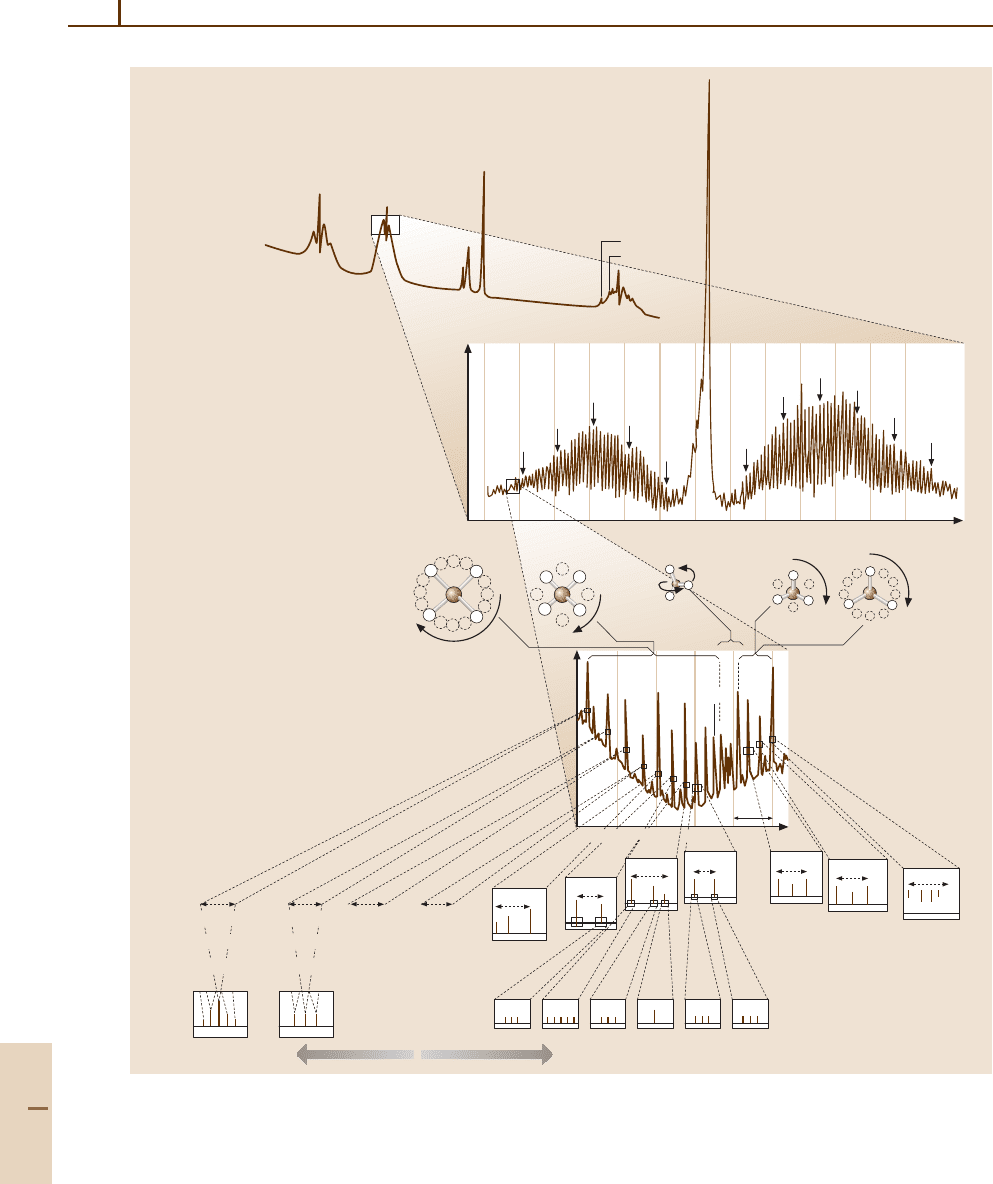
504 Part C Molecules
cm
–1
600 610 620 630 640 650 660
…
...................
a)
b)
c)
d)
e)
CF
4
vibrational structure
ν
4
rotational structure
P(54) fine (centrifugal)
structure
Superfine (“Tumbling”)
structure
ν
2
= 435.0 cm
–1
ν
4
= 631.2 cm
–1
ν
1
= 908.5 cm
–1
ν
3
= 1283.0 cm
–1
ν
3
(
13
C)
2ν
4
P(50)
P(40)
P(30)
P(20)
P(10)
R(10)
Q
R(20)
R(30)
R(40)
R(50)
R(60)
Faster
4-fold
rotation
Faster
3-fold
rotation
54
53
52
51
50
48
49
47
46
45
44
51
52
53
54
3.0 Ghz
603.3 603.4 603.5 603.6 cm
–1
2-fold
tumbling
P(54)
Hyperfine (nuclear spin) structure
3.5 mHz
9.7 mHz
9.4 Hz 110 Hz
Case (2) Case (1)
EF
2
A
2
F
2
F
1
A
1
F
1
EF
2
F
1
2.7 kHz
20 kHz
2.6 MHz
120 MHz
9.9 MHz
48 kHz
0.97 MHz
EF
2
A
2
F
2
F
1
F
1
A
1
E
F
2
F
1
F
1
F
2
E
F
1
F
2
E
F
2
A
2
A
1
F
1
⬃1–100 kHz
⬃ 50 kHz
Fig. 32.7a–e Rovibrational structure in the 630 cm
−1
or 16 µm bands of CF
4
[32.16]. (a) Vibrational resonances and
band profiles. (Raman spectra from [32.23]).
(b) Rotational P, Q,andR band structur corresponding to J → J −1,
J → J +1 transitions. (FTIR spectra from [32.24]).
(c) P(54) rotational fine structure due to rotation–vibration coupling
and angular momentum precessional motion. (Laser diode spectra from [32.25]).
(d) Superfine structure due to precessional
tunneling [32.26].
(e) Hyperfine structure due to nuclear spin precession [32.26]
Part C 32.5

Molecular Symmetry and Dynamics 32.5 High Resolution Rovibrational Structure 505
transition, and is just one of many vibrational structures
to study. The P(54) sideband resonance in part (b) cor-
responds to a (J = 54) → (J −1) rotational transition,
and is just one of hundreds of rotational structures to
study within the ν
4
bands.
Each band is something like a Russian doll; it con-
tains structure within structure within structure down to
the resolution of few tens of Hz. Examples of rotational
fine and superfine structures described in Sect. 32.4
are shown in Fig. 32.7c, d, but even more resolution
is needed to see the hyperfine structure in Fig. 32.7e.
Such extremely high resolution has been reached with
aCO
2
saturation absorption spectrometer [32.27, 28].
The 10 µm bands of SF
6
and SiF
4
have been studied in
this manner, the latter being similar to CF
4
[32.26].
32.5.1 Tetrahedral Nuclear Hyperfine
Structure
High resolution spectral studies of SiF
4
showed unantic-
ipated effects involving the four fluorine nuclear spin and
magnetic moments and their associated hyperfine states.
First, the Pauli principle restricts the nuclear spin multi-
plicity associated with each of the rotational symmetry
species in much the same way that atomic L −S coupled
states
2S+1
L have certain spin multiplicities (2S +1) al-
lowed for a given orbital L species involving two or
more equivalent electrons. Second, since superfine split-
tings can easily be tiny, different spin species can end
up close enough that hyperfine interactions, however
small, can cause strongly resonant mixing of the nor-
mally inviolate species. Finally, a pure and simple form
of spontaneous symmetry breaking is observed in which
otherwise equivalent nuclei fall into different subsets
due to quantum rotor dynamics.
Connecting nuclear spin to rotational species is done
by correlating the full permutation symmetry (S
n
for
XY
n
molecules) with the full molecular rotation and par-
ity symmetry [O(3)
LAB
⊗T
dBODY
for CF
4
molecules or
O(3)
LAB
⊗O
hBODY
and for SF
6
]. For four spin-1/2 nu-
clei, the Pauli principle allows a spin of I = 2 and a spin
multiplicity of five (2I +1 = 5) for (J
+
, A
2
)or(J
−
, A
1
)
species, but excludes (J
−
, A
2
)or(J
+
, A
1
) species alto-
gether. The Pauli allowed spin for (J
+
, T
1
)or(J
−
, T
2
)
species is I = 1 with a multiplicity of three, but there are
no allowed (J
+
, T
2
) or (J
−
, T
1
) species. Finally, both
(J
+
, E) and (J
−
, E) belong to singlet spin I = 0and
are singlet partners to an inversion doublet. (None of the
other species can have both + and − parity.)
The E inversion doublet is analogous to the doublet
in NH
3
which is responsible for the ammonia maser.
However, NH
3
-type inversion is not feasible in CF
4
or SiF
4
, and so the splitting of the E doublet in these
molecules is due to hyperfine resonance [32.9, 16, 23].
The Pauli analysis gives the number of hyperfine
lines that each species would exhibit if it were isolated
and resolved, as shown in the center of Fig. 32.7e. The
rotational singlets A
1
and A
2
have five lines each, the
rotational triplets T
1
and T
2
are spin triplets, and the
rotational doublet E is a spin singlet but an inversion
doublet. If the hyperfine structure of a given species A
1
,
A
2
, T
1
, T
2
,orE is not resolved, then their line heights
are proportional to their total spin weights of 5, 5, 3, 3,
and 2, respectively.
If the unresolved species are clustered, then the total
spin weights of each add to give a characteristic clus-
ter line height. The line heights of the C
4
clusters (T
1
,
T
2
),(A
2
, T
2
, E),(T
1
, T
2
),(E, T
1
, A
1
) are 6, 10, 6, 10,
respectively. The line heights of the C
3
clusters (A
1
,
T
1
, T
2
, A
2
),(T
1
, E, T
2
),(T
1
, E, T
2
) are 16, 8, 8, respec-
tively. This is roughly what is seen in the P(54) spectrum
in Fig. 32.7c.
32.5.2 Superhyperfine Structure
and Spontaneous Symmetry
Breaking
The superfine cluster splittings (2S,4S, etc.) are propor-
tional to the J-precessional tunneling or ‘tumbling’ rates
between equivalent C
3
or C
4
symmetry axes, and they
decrease with increasing K
3
or K
4
. At some point, the
superfine splittings decrease to less than the hyperfine
splittings which are actually increasing with K .There-
sulting collision of superfine and hyperfine structure has
been called superhyperfine structure or Case 2 clusters.
The following is a rough sketch of the phenomenology
of this very complex effect, using the results of Pfis-
ter [32.26].
As long as the tunneling rates are > 1MHz, the
nuclear spins will tend to average over spherical top
motion. The spins couple into states of good total nu-
clear spin I , which in turn couple weakly with the overall
angular momentum and with well defined rovibrational
species A
1
, A
2
, T
1
, T
2
,orE as described above. The re-
sulting coupling is called Case 1, and is analogous to LS
coupling in atoms.
Stick figures for two examples of spectra observed
by Pfister [32.26]areshowninFig.32.8aandb.Thefirst
Case 1 cluster, shown in (a), is a C
4
type (0
4
)cluster(A
1
,
T
1
, E), which was solved in Table 32.6. The other Case
1 cluster, shown in (b), is a C
3
type (±1
3
)cluster(T
1
,
E, T
2
) (recall the C
3
correlations in Fig. 32.3). They are
Part C 32.5
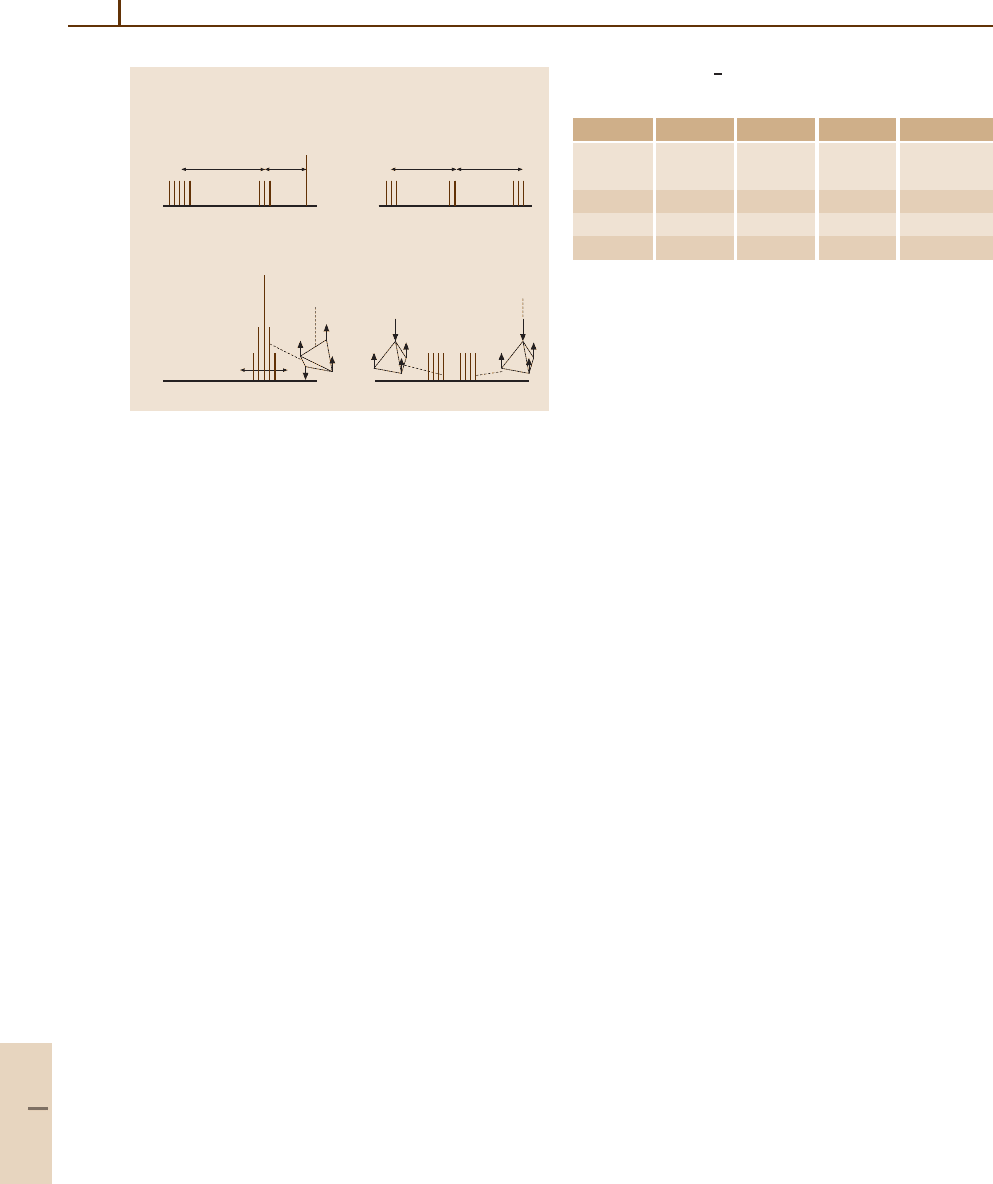
506 Part C Molecules
(mixed)
a) b)
c) d)
C
4
Cluster (Case 1) C
3
Cluster (Case 1)
C
3
Cluster (Case 2)C
4
Cluster (Case 2)
R(17)
K
4
=16
Θ
17
16
= 23.8°
4S = 4.7 MHz
2S
A
1
T
1
E
R(32)
K
4
=32
Θ
32
32
=10.0°
A
1
T
1
E(mixed)
R(34)
K
3
=34
Θ
34
34
= 9.7°
2S
T
1
T
2
E
2S = 0.8 MHz
R(50)
K
3
=50
Θ
50
50
= 8.0°
(S 艐 0)
艐 40 kHz
(S 艐 17 kHz)
T
1
T
2
E
Fig. 32.8a–d Stick sketches for example of superfine
and hyperfine spectral structure found by Pfister [32.26];
(a),(b) Case 1 clusters (high tunneling amplitude S);
(c),(d) Case 2 clusters (low tunneling amplitude S)
similar to the corresponding sketches in Fig. 32.7e. One
notable difference is that the inversion doublet shows
little or no splitting in the (A
1
, T
1
, E) cluster, but does
split in the (T
1
, E, T
2
) cluster.
When the tunneling rates fall below 10 or 20 kHz,
the angular momentum can remain near a particular C
3
or C
4
symmetry axis for a time longer than the nu-
clear spin precession rates. Spin precession rates and
the corresponding hyperfine splittings are ≈ 50 kHz,
and increase with K . Hence, there is plenty of time
for each of the nuclear spins to align or anti-align with
the C
3
or C
4
symmetry axes of rotation. This is called
Case 2 coupling, and the resulting spectrum resembles
that of an NMR scan of the nuclei, but here the mag-
netic field is provided by the molecule’s own body frame
rotation.
If SiF
4
rotates uniformly about one C
4
symmetry
axis, then all four F nuclei occupy equivalent positions
at the same average distance from the rotation axis and
experience the same local magnetic fields. The mol-
ecule can be thought of as a paired diatomic F
2
–F
2
rotor
with each one symmetrized or antisymmetrized so as
to make the whole state symmetric. Table 32.6 shows
the spin-
1
/
2
base states arranged horizontally accord-
ing to the total projection I
z
of nuclear spins on the C
4
axis. Horizontal arrays (↑↓) of spins denote symmetric
states, while vertical arrays () denote antisymmetric
spin states.
The hyperfine energy is approximately propor-
tional to the projection I
z
. The resulting spectrum
Table 32.6 Spin −
1
2
basis states for SiF
4
rotating about
aC
4
symmetry axis
I
z
= 2 I
z
= 1 I
z
= 0 I
z
=−1 I
z
=−2
↑↑
↓↓
|
↑↓ ↑↓
|
↑↓ ↑↑
|
↓↓ ↑↑
|
↓↓ ↑↓
|
↑↑ ↑↑
|
↑↑ ↑↓
|
↑↑ ↓↓
|
↑↓ ↓↓
|
↓↓ ↓↓
is (1, 2, 4, 2, 1)-degenerate pyramid of equally spaced
lines as shown in Fig. 32.8c. Four spin-1/2 states without
symmetry restrictions would give the standard binomial
(1, 4, 6, 4, 1)-degeneracy seen in NMR spectra.
If the molecule settles upon C
3
symmetry axes of
rotation, the situation is markedly different. The four
nuclei no longer occupy equivalent positions. One nu-
cleus sits on the rotation axis, while the other three nuclei
occupy equivalent off-axis positions. The off-axis nuclei
experience a different local magnetic field than the sin-
gle on-axis nucleus (Fig. 32.8d). From the spectrum, it
appears that the spin-up to spin-down energy difference
is much greater for the lone on-axis nucleus than for
the three equatorial nuclei, whose spin states form the
energy quartet
{|
↑↑↑
,
|
↑↑↓
,
|
↑↓↓
,
|
↓↓↓
}
. The on-
axis nucleus has an energy doublet with a large splitting,
so that the four nuclei together give a doublet of quartets
as shown in the figure.
If the off-axis nuclei had experienced the greatest
splitting, then the spectrum would have been a quartet
of doublets instead of a doublet of quartets. Something
like this does occur in the SF
6
superhyperfine struc-
ture, which shows a quintet of triplets for a Case-2
C
4
-symmetry cluster. For either one of these molecules,
it is remarkable how different the rovibrational ‘chem-
ical shifts’ can become for equivalent symmetry sites.
The result is a microscopic example of spontaneous
symmetry breaking.
32.5.3 Extreme Molecular Symmetry Effects
The most common high symmetry molecules belong to
either the tetrahedral T
d
or cubic-octahedral O groups.
Until the recent discovery of fullerenes and the structure
of virus coats, the occurrence of molecular point groups
of icosahedral symmetry was thought to be rare or non-
existent in nature [32.24,25].
For an extreme example of symmetry breaking ef-
fects, consider the Buckminsterfullerene or Buckyball
molecule C
60
which has the highest possible molecular
point symmetry Y
h
. A semiclassical approach to rota-
Part C 32.5

Molecular Symmetry and Dynamics 32.6 Composite Rotors and Multiple RES 507
tional symmetry and dynamics is useful here since the
rotational quantum constant is so small for the fullerenes
(for C
60
2B = 0.0056 cm
−1
or 168 MHz) [32.29–31].
Since there are two isotopes
12
C (nuclear spin 0)
and
13
C (nuclear spin 1/2) it is possible to have a Bose-
symmetric molecule (
12
C
60
), or Fermi-symmetric
molecule (
13
C
60
), or many broken-symmetry combin-
ations (
12
C
x
13
C
60−x
). The most likely combination is
12
C
59
13
C, which has no rotational symmetry at all, only
one reflection plane. This may be the most extreme ex-
ample of molecular isotopic symmetry breaking; it goes
from the highest possible symmetry Y
h
to one of the
lowest, C
h
.
The Fermi-symmetric molecule
13
C
60
has ten times
as many rotating spin-1/2 nuclei as SF
6
,and2
10
times
as many hyperfine states, or about 1.15 × 10
18
spin states
distributed among 10 symmetry species [32.32]. In con-
trast,the Bose-symmetric molecule
12
C
60
has only one
spin symmetry species allowed by the Bose exclusion
principle: A
1g
. It provides an even more extreme ex-
ample of Bose exclusion than the Os
16
O
4
molecule. In
all, 119 of the 120 Y
h
rovibrational symmetry states are
Bose-excluded, giving
12
C
60
an extraordinarily sparse
rotational structure. However, it only takes the addi-
tion of a single neutron to make
12
C
59
13
C. Then all the
excluded rovibrational states must return!
32.6 Composite Rotors and Multiple RES
So far, the discussion has focused on Hamiltonians and
RES involving functions of even mulipolarity, i. e., con-
stant (k =0), quadrupole (k =2), hexadecapole (k =4),
while ignoring odd functions, i. e., dipole (k = 1),oc-
tupole (k = 3), for reasons of time-reversal symmetry.
However, for composite “rotor-rotors” any mulitpolarity
is possible, and the dipole is of primary utility.
A composite rotor is one composed of two or more
objects with more or less independent angular momenta.
This could be a molecule with attached methyl (CH
3
)
“gyro” or “pinwheel” sub-rotors, a system of consid-
erable biological interest. It could be a molecule with
a vibration or “phonon” excitation that couples strongly
to rotation. Also, any nuclear or electronic spin with
significant coupling may be regarded as an elemen-
tary sub-rotor. The classical analogy is a spacecraft with
gyros on board.
A rotor–rotor Hamiltonian has the general interac-
tion form
H
rotor R+S
= H
rotor
R
+ H
rotor
S
+V
RS
. (32.19)
A useful approximation assumes that rotor S,the
“gyro”, is fastened to the frame of rotor R, so that the
interaction V
RS
becomes a constraint, does no work,
and is thus assumed to be zero. An asymmetric top with
body-fixed spin has the Hamiltonian
H
R+S(Body-fixed)
= AR
2
x
+ BR
2
y
+C R
2
z
+ H
rotor
S
+(∼ 0), (32.20a)
which is a modified version of (32.1). The total
angular momentum of the system is a conserved
vectorJ = R+S in the lab-frame and a conserved mag-
nitude |J| in the rotor-R body frame. So we use
R= J−S in place of R:
H
R,S(fixed)
= A
(
J
x
−S
x
)
2
+ B
J
y
−S
y
2
+C
(
J
z
−S
z
)
2
+ H
rotor
S
= AJ
2
x
+ B J
2
y
+C J
2
z
−2A J
x
S
x
−2B J
y
S
y
−2C J
z
S
z
+ H
rotor
S
.
(32.20b)
The gyro spin components S
a
are first treated as constant
classical parameters S
a
:
H
R,S(fixed)
= const. 1−2AS
x
J
x
−2BS
y
J
y
−2CS
z
J
z
+ A J
2
x
+ B J
2
y
+C J
2
z
= M
0
T
0
0
+
d
D
d
T
1
d
+
q
Q
q
T
2
q
.
(32.20c)
This is a simple Hamiltonian multipole tensor op-
erator expansion having here just a monopole T
0
0
term,
three dipole T
1
a
terms, and two quadrupole T
2
q
terms.
Figure 32.9 shows these three tensor terms, where each
graph is a radial plot of a spherical harmonic function
Y
k
q
(
φ, Φ
)
representing a tensor operator T
k
q
. The tensor
components are
T
0
0
=
J
2
x
+ J
2
y
+ J
2
z
3
(32.21a)
T
1
x
= J
x
=
T
1
+1
+T
1
−1
√
2
T
1
y
= J
y
=
T
1
+1
−T
1
−1
i
√
2
T
1
z
= J
z
= T
1
0
(32.21b)
Part C 32.6
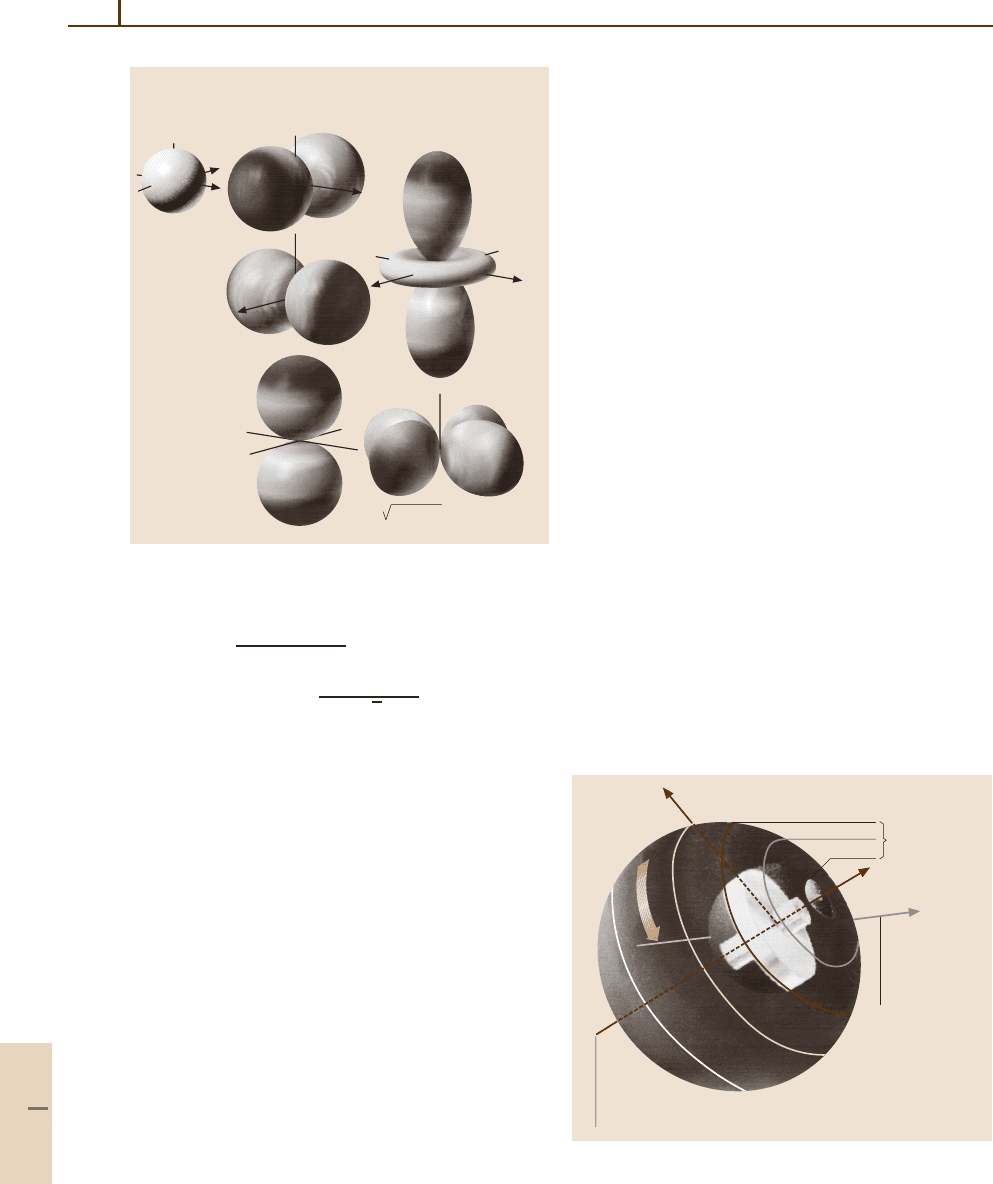
508 Part C Molecules
a) b) c)
Monopole Dipole Quadrupole
T
0
0
T
1
x
T
2
0
T
1
y
T
1
z
2z
2
– x
2
–y
2
T
2
+2
– T
2
–2
3(x
2
–y
2
)
Fig. 32.9a–c The six lowest order RES components
needed to describe rigid gyro-motors
T
2
zz
=
2J
2
z
− J
2
x
− J
2
y
2
= T
2
0
T
2
x
2
−y
2
= J
2
x
− J
2
y
=
2
T
2
2
−T
2
−2
√
6
(32.21c)
The constant coefficients or moments indicate the
strength of each multipole symmetry:
M
0
= A + B +C +3H
rotor
S
(32.22a)
D
x
=−2AS
x
,
D
y
=−2BS
y
,
D
z
=−2CS
z
(32.22b)
Q
zz
=
(
2C − A − B
)
/6
Q
x
2
−y
2
=
(
A − B
)
/2 (32.22c)
The scalar monopole RES (a) is a sphere, the vector
dipole RES (b) are bi-spheres pointing along Cartesian
axes, and the RES (c) resemble quadrupole antenna
patterns. Also, Fig. 32.9a–cplotthesixs,p,andd
Bohr–Schrödinger orbitals that are analogs for the six
octahedral J-tunneling states listed in Table 32.5.
The asymmetric and symmetric rotor Hamil-
tonians (32.1)and(32.1) are combinations of
a monopole (32.21a), which by itself makes a spher-
ical rotor, and varying amounts of the two quadrupole
terms (32.21c) to give the rigid rotor RES pic-
tured in Figs. 32.1 and Fig. 32.2.TheQ coefficients
in (32.22c) are both zero for a spherical top
(A = B = C), but only one is zero for a symmetric top
(A = B).
Combining the monopole (32.21a) with the
dipole terms (32.21b) gives the gyro-rotor Hamilto-
nian (32.20b) for a spherical rotor (A = B = C):
H = const + BJ
2
−gµS· J , (32.23)
where −gµ = 2A = 2B = 2C. This Hamiltonian re-
sembles a dipole potential −m· B for a magnetic
moment m = g J that precesses clockwise around a lab-
fixed magnetic field B = µS. (The PE is least for J
along S.)
The Hamiltonian (32.23)isasimpleexampleof
Coriolis rotational energy. It is least for J along S,where
|R|=|J−S| and the rotor kinetic energy BR
2
are least.
(Magnitudes |J| and |S| are constant here.) The spher-
ical rotor-gyro RES in Fig. 32.10 has a minimum along
the body-axis +Sand a maximum along −S,whereBR
2
is greatest.
As is the case for the rigid solid rotors in Figs. 32.1
and Fig. 32.2,theRES topography lines determine the
precession J-paths in the body frame, wherein gyro-S
is fixed, as shown in Fig. 32.10. The left-hand rule gives
the sense of the J-precession in the body S-frame, i. e.,
all J precess counterclockwise relative to the “low” on
the +S-axis, or clockwise relative to the “high” on the
−S-axis. In the lab, S precesses in a clockwise manner
around a fixed J.
Precessing
J vector
Linear
harmonic
precession
spectra
Lowest RE
for gyro-rotor
at North pole
fixed point
Highest RE for gyro-rotor
at South pole fixed point
S
Fig. 32.10 The spherical gyro-rotor RES is a cardioid of
revolution around gyro spin S
Part C 32.6

Molecular Symmetry and Dynamics 32.6 Composite Rotors and Multiple RES 509
Gyro-RES differ from solid rotor RES, which have
two opposite “highs” and/or two opposite “lows” sepa-
rated by saddle fixed points where the precessional flow
direction reverses, as seen in Fig. 32.2. The gyro-RES
in Fig. 32.10 has no saddle fixed points, and thus has only
one “high” and one direction of flow with the same har-
monic precession frequency for all J-vectors between
the high +S and low −S-axes. This is because the spec-
trum of the gyro-rotor Hamiltonian (32.23) is harmonic,
or linear, in the K:
J
K
H
J
K
= const. +BJ(J +1) −2BK .
(32.24)
In contrast, even the symmetric rigid rotor spec-
trum (32.4) is quadratic in K . Other rotors shown
in Figs. 32.2 and Fig. 32.4 have levels that have an even
more nonlinear spacing.
32.6.1 3D-Rotor and 2D-Oscillator Analogy
Linear levels are usually associated with harmonic
oscillators not rotors, but the gyro-rotor’s linear spec-
trum highlights a 160-year-old analogy between the
motions of 3D rotors and 2D vibrations [32.33–45].
Stokes [32.35] first described 2D electric vibration or
optical polarization, by a 3D vector that became known
as the Stokes vector S, and later as the “spin” S.
The Stokes spin was based on Hamilton’s quater-
nions q
µ
[32.33,34]. The Pauli spinors σ
µ
= iq
µ
[32.36]
were defined, 83 years later, as components of a general
2D Hermitian matrix H. Spinors square to the unit ma-
trix
σ
2
µ
= 1 =σ
0
, while quaternions square to –1.The
3D Hamiltonian is
H =
AB−iC
B +iCD
=
A + D
2
σ
0
+
A − D
2
σ
A
+ Bσ
B
+Cσ
C
, (32.25)
where
σ
0
=
10
01
,σ
A
=
10
0 −1
,
σ
B
=
01
10
,σ
C
=
0 −i
i 0
.
The 3D-component labels
A−D
2
(Asymmetric-
diagonal), B (Bilateral-balanced), and C (Circular-
Coriolis) are ABC mnemonics for Pauli’s z, x,andy,
respectively. The 2D operator H has a 1+S· J form of
the Coriolis coupling Hamiltonian (32.23):
H = S
0
1+S
A
J
A
+S
B
J
B
+S
C
J
C
= S
0
J
0
+S · J , (32.26)
where
J
0
= 1 , J
A
=
σ
A
2
, J
B
=
σ
B
2
, J
C
=
σ
C
2
,
and
S
0
= (A +D)/2 , S
A
= (A −D), S
B
= 2B ,
S
C
= 2C .
The elementary 2D-oscillator ladder operators a
†
,
and a make the 2D-3D theory more powerful. This is
known as the Jordan–Schwinger map [32.37–39]be-
tween 2D oscillation and 3D rotation. In terms of the
ladder operators
J
0
= N = a
†
1
a
1
+a
†
2
a
2
, J
A
=
1
2
a
†
1
a
1
−a
†
2
a
2
,
J
B
=
1
2
a
†
1
a
2
+a
†
2
a
1
, J
C
=
−i
2
a
†
1
a
2
−a
†
2
a
1
.
(32.27)
where
a
†
1
a
1
=
10
00
, a
†
1
a
2
=
01
00
,
a
†
2
a
1
=
00
10
, a
†
2
a
2
=
00
01
.
The a
†
a-algebra gives Schwinger’s 3D angular mo-
mentum raising and lowering operators J
+
= J
B
+
iJ
C
= a
†
1
a
2
and J
−
= J
B
−iJ
C
= a
†
2
a
1
, where in two
dimensions 1 and 2 are spin-up (+
/2) and spin-down
(−
/2), instead of the x-and y-polarized states envi-
sionedbyStokes.
The angular 3D ladder operation is replaced by
a simpler 2D oscillator operation:
J
+
|n
1
n
2
=a
1
†
a
2
|
n
1
n
2
=
n
1
+1
√
n
2
|
n
1
+1, n
2
−1
,
J
−
|
n
1
n
2
= a
†
2
a
1
|
n
1
n
2
=
√
n
1
n
2
+1
|
n
1
−1, n
2
+1
. (32.28)
The 2D oscillator states are labeled by the to-
tal number N = (n
1
+n
2
) of quanta and the net
quantum population ∆N = (n
1
−n
2
). The 3D angular
momentum states
J
K
are labeled by the total mo-
mentum J = N/2 = (n
1
+n
2
)/2andthez-component
Part C 32.6
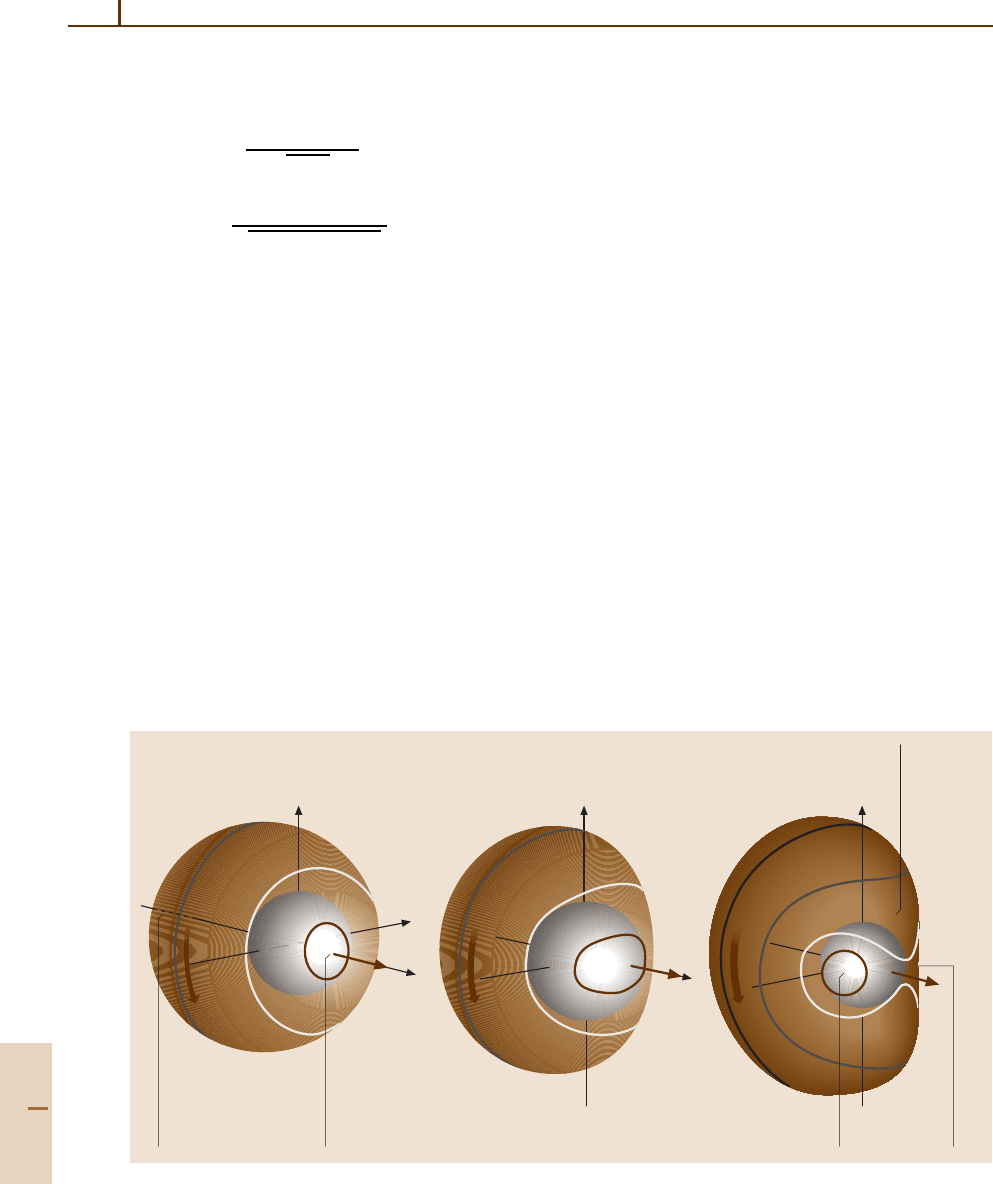
510 Part C Molecules
K = ∆N/2 = (n
1
−−n
2
)/2, just half (or η/2) of N
and ∆N.
|
n
1
, n
2
=
a
†
1
n
1
a
†
2
n
2
√
n
1
!n
2
!
|
0, 0
=
J
K
=
a
†
1
J+K
a
†
2
J−K
√
(
J +K
)
!
(
J −K
)
!
|
0, 0
,
(32.29)
where
n
1
= J + K , n
2
= J − K .
From this Schwinger [32.38] rederived the Wigner
matrices D
J
MK
(
αβγ
)
, which appear in (32.5)and(32.6),
and the Wigner–Eckart or Clebsch–Gordan matrix val-
ues. This helps clarify the approximation of these values
by (J, K)−cone levels around RES hills or valleys
[recall (32.10)and(32.11)], since
J
K
T
k
0
J
K
= C
kJJ
0KK
J
k
J
∼ D
J
JK
Θ
J
K
.
32.6.2 Gyro-Rotors
and 2D-Local Mode Analogy
The 2D–3D analogy provides insight into spin [32.40–
42] and rovibrational dynamics [32.40–45], as well as
having computational value. Consider extending a sin-
gle 2D-oscillator-rotor analogy in the Stokes model to
S
BA
–B fixed pt.
Anti-symmetric
normal mode
+B fixed pt.
Symmetric
normal mode
C (or y)
S
TT
0
(0)
+ D
y
(1)
T
y
(1)
+ Q
0
(2)
T
0
(2)
Symmetric
normal
mode
becomes
unstable
+A fixed pt.
Local Mode-1
–A fixed pt.
Local Mode-2
a) b) c)
Spherical gyro-rotor
or normal B-modes
Perturbed gyro-rotor
or “soft” + B-mode
Symmetric gyro-rotor
or local A-mode
normal –B-mode
(or z) (or x)
TT
0
(0)
+ D
y
(1)
T
y
(1)
Fig. 32.11a–c A spherical gyro-rotor becomes a symmetric gyro-rotor by adding T
2
0
a model of two 1D oscillators with coordinates x
1
= x
and x
2
= y.
Identical side-by-side oscillators have bilateral
B-symmetry. The Hamiltonian H
B
commutes with the
matrices σ
B
(+45
◦
mirror reflection of axes ±x ±y)
and −σ
B
(−45
◦
mirror reflection of axes ∓x ±y),
both of which switch oscillators. A first-order bilat-
eral Hamiltonian is H
B
= 2Bσ
B
. This is analogous to
a gyro rotor T
1
x
with S along the B-axis, as shown
in Fig. 32.11a. (The added unit operator T
0
0
shifts levels,
but does not affect eigenstates.)
The eigenstates of H
B
are the symmetric and anti-
symmetric normal modes that belong to the fixed points
on the S-vector or ±B-axes of the 3D Stokes space.
If instead, the S-vector lies on the A-axis, the Hamil-
tonian is an asymmetric diagonal H
A
= 2Aσ
A
matrix.
From (32.25) we see that the operator σ
A
reflects y into
−y but leaves x alone, so that the eigenvectors of H
A
are localized on the x-oscillator or the y-oscillator, but
not on both. Such motions are local modes, but they are
not modes of H
B
since it does not commute with H
A
.
If the vector J is on the +A-axis (local x-mode),
the Hamiltonian H
B
rotates J to the −C-axis, then to
the −A-axis (local y-mode), then to the +C-axis, and
then back to the +A-axis. This J-path is the equator
of Fig. 32.11a. The ±C-axes label circular polariza-
tion with right and left chirality, respectively. Twice
during a B-beat, J passes the ±C-axes, where one vi-
brator’s phase is 90
◦
ahead and resonantly pumping
Part C 32.6
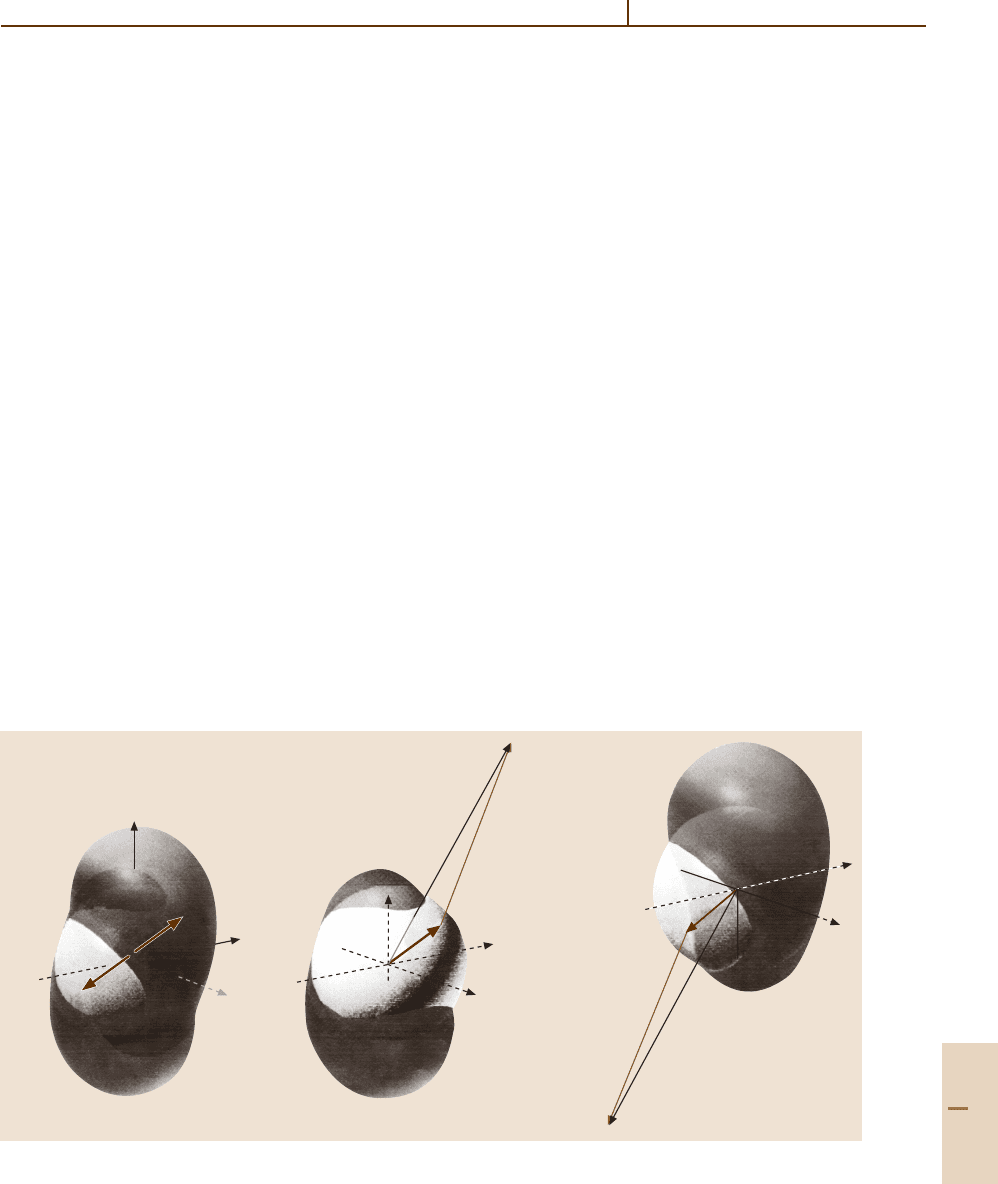
Molecular Symmetry and Dynamics 32.6 Composite Rotors and Multiple RES 511
the other. Such bilateral beat and resonant transfer is
disrupted by adding anharmonic T
2
0
or T
2
±2
terms to
the B-symmetry terms T
1
x
and T
0
0
. Adding T
2
0
causes
B-circles in Fig. 32.11(a) to distort near the B-axis, as
showninFig.32.11b–c.
In molecular rotation theory, the T
2
0
and T
0
0
terms
comprise the initial unperturbed Hamiltonian (32.3)of
a symmetric top, while the gyro terms T
1
q
are viewed as
perturbations in (32.20), due to an “on-board” gyro rotor.
For vibration theory, the T
1
q
terms make up a normal-
mode Hamiltonian, and the T
2
0
term is viewed as an
anharmonic perturbation.
The effect of T
2
0
, seen in Fig. 32.11c, is to replace
the stable fixed point +B (representing the (+)-normal
mode) by a saddle point as B bifurcates (splits) into
a pair of fixed points that head toward the ±A-axes.
So one normal mode dies and begets two stable local
modes, wherein one mass may keep its energy, and not
lose it to the other through the usual B-beating process.
(The A-modes become anharmonically detuned.)
Pairs of classical modes, each localized on differ-
ent sides of the RES in Fig. 32.11, are analogous to
the asymmetric top ±K-precession pairs in Fig. 32.2
with degenerate energy in a classical RES picture. The
quantum-tunneling Hamiltonian (32.15) splits each tra-
jectory pair into a superfine doublet with (±)-eigenstates
sharing both RES paths, as seen in Table 32.1. The quan-
tum gyro-spin doublets also share ±J components both
upanddownthe A-axis, as seen in Fig. 32.11c.
a)
Composite S rotational
energy surface
b) c)
Forward gyro-spin
+S= (1, 1, 1)
Time reversed gyro
–S= (–1, –1, –1)
S
J
z
–S
J
y
J
x
S
JR
JR
–S
Fig. 32.12a–c Asymmetric gyro-rotor RES (classical body-fixed-spin case); (a) Composite ±S; (b) Forward spin ±S;
(c) Reversed spin −S
32.6.3 Multiple Gyro-Rotor RES
and Eigensurfaces
While simple quantum rotors delocalize J to multiple
RES paths, a gyro-rotor J may delocalize to mul-
tiple paths and surfaces. Gyro-rotor RES vary with S,
and if S is a quantum spin, the possibility arises for
a distribution over multiple RES [32.46, 47]. A sim-
ple quantum theory of S allows both +S and −S at
once. The RES for each is plotted one on top of the
other, as in Fig. 32.12a, while component RES are shown
in Fig. 32.12bfor+S andinFig.32.12cfor−S.An
energy sphere is shown intersecting an RES pair for
an asymmetric gyro-rotor. If the spin S is set to zero,
the pair of RES collapses into a rigid asymmetric top
RES, shown in Fig. 32.2, having angular inversion (time-
reversal J →−J)andD
2h
reflection symmetry. The
composite RES in Fig. 32.12a has inversion symmetry,
but lacks reflection symmetry. Its parts in Fig. 32.12b
and c have neither inversion nor reflection symmetry if
gyro-spins ±S are off-axis.
The gyro-rotor Hamiltonian (32.20) allows tunnel-
ing or mixing of multiple RES. A two-state spin−1/2
gyro-spin model has a 2 ⊗2 Hamiltonian matrix and two
base-RES:
H
gyro
= M
0
J· J+ D
x
S
x
J
x
+ D
y
S
y
J
y
+ D
z
S
z
J
z
+ Q
xx
J
2
x
+ Q
yy
J
2
y
+ Q
zz
J
2
z
(32.30)
Part C 32.6

512 Part C Molecules
As in (32.7), J is approximated by classical vector
components in the body frame:
J
x
=
|
J
|
sin β cos γ, J
y
=
|
J
|
sin β sin γ,
J
z
=
|
J
|
cos β
. (32.31a)
But the gyro-spin S uses its quantum representation S=
|S|σ /2 =
√
3σ /2 from (32.25):
H
gyro
= M
0
J
2
+ Q
xx
J
2
x
+ Q
yy
J
2
y
+ Q
zz
J
2
z
+ D
x
|
S
|
σ
x
J
x
+ D
y
|
S
|
σ
y
J
y
+ D
z
|
S
|
σ
z
J
z
=
h
(
J
)
+ D
z
|
S
|
J
z
|
S
|
D
x
J
x
−iD
y
J
y
|
S
|
D
x
J
x
+iD
y
J
y
h
(
J
)
− D
z
|
S
|
J
z
=
h
(
J
)
+d
z
cos β
d
x
cos γ −id
y
sin γ
×sinβ
d
x
cos γ +id
y
sin γ
h
(
J
)
−d
z
cos β
×sinβ
,
(32.31b)
where
h
(
J
)
= M
0
J
2
+ Q
xx
J
2
x
+ Q
yy
J
2
y
+ Q
zz
J
2
z
and
d
µ
= D
µ
|S||J| . (32.31c)
The dynamics generated by Hamiltonian approx-
imations such as (32.31b) are analogous to other
semiclassical approximations, such as the Maxwell–
Bloch model of an atom in a cavity. Their solutions
are very complicated and often chaotic. The classical
variable ( J in this case) follows phase contours on
a changing RES that depends on the instantaneous ex-
pectation values of the quantum variables (S in this
case), which in turn vary according to the instantaneous
classical variables.
In spite of this complexity, semiclassical spectra
may be approximated using RES pairs obtained from
eigenvalues of a 2 ⊗2matrixsuchas(32.31b) for each
classical angular orientation (βγ) of the J-vector in the
body frame [32.46,47]. The results are pairs of surfaces
roughly like those in Fig. 32.12a, but without the inter-
section lines. The Wigner non-crossing effect prevents
degeneracy, except at isolated points.
Near-crossing RES are the rotational equivalent
of near-crossing vibrational-potential energy surfaces
(VES) described in treatments of Jahn–Teller ef-
fects [32.48, 49]. The classical, semiclassical, and
quantum theory for such loosely-bound or fluxional sys-
tems is still inits infancy, but is potentially a very rich
source of new effects.
References
32.1 G. Herzberg: Molecular Spectra and Structure: Vol. I,
Spectra of Diatomic Molecules (Van-Norstrand-
Reinhold, New York 1950)
32.2 G. Herzberg: Molecular Spectra and Structure:
Vol. II, Infrared and Raman Spectra of Poly-
atomic Molecules (Van-Norstrand-Reinhold, New
York 1945)
32.3 G. Herzberg: Molecular Spectra and Struc-
ture: Vol. III, Electronic Structure of Polyatomic
Molecules (Van-Norstrand-Reinhold, New York
1966)
32.4 F. B. Wilson, V. C. Decius, P. C. Cross: Molecular Vi-
brations (McGraw Hill, New York 1955)
32.5 D. Papousek, M. R. Aliev: Molecular Vibrational-
Rotational Spectra, Studies Phys. Theor. Chem. 17
(Elsevier, Amsterdam 1982)
32.6 R. N. Zare: Angular Momentum: Understanding
Spatial Aspects in Chemistry and Physics (Wiley
Interscience, New York 1988)
32.7 W. G. Harter: Principles of Symmetry, Dynamics,
and Spectroscopy (Wiley Interscience, New York
1993)
32.8 W. G. Harter, C. W. Patterson: J. Math. Phys. 20,1453
(1979)
32.9 W. G. Harter: Phys. Rev. A 24, 192 (1981)
32.10 W. G. Harter, C. W. Patterson: J. Chem. Phys. 80,
4241 (1984)
32.11 W. G. Harter: Comp. Phys. Rep. 8, 319 (1988)
32.12 D. A. Sadovskii, B. I. Zhilinskii: Mol. Phys 65,109
(1988)
32.13 D. A. Sadovskii, B. I. Zhilinskii: Phys. Rev. A 47, 2653
(1993)
32.14 I. M. Pavlichenkov: Phys. Rep. 226, 173 (1993)
32.15 W. G. Harter, C. W. Patterson, F. J. daPaixao: Rev.
Mod. Phys. 50, 37 (1978)
32.16 W. G. Harter, C. W. Patterson: Phys. Rev. A 19, 2277
(1979)
32.17 P. R. Bunker: Molecular Symmetry and Spectroscopy
(Academic, New York 1979)
32.18 K. T. Hecht: J. Mol. Spectrosc. 5,355(1960)
32.19 K. R. Lea, M. J. M. Leask, W. P. Wolf: J. Phys. Chem.
Solids 23, 1381 (1962)
32.20 A. J. Dorney, J. K. G. Watson: J. Mol. Spectrosc. 42,1
(1972)
32.21 K. Fox, H. W. Galbraith, B. J. Krohn, J. D. Louck:
Phys. Rev. A 15, 1363 (1977)
32.22 W. G. Harter, C. W. Patterson: J. Chem. Phys. 66,
4872 (1977)
Part C 32

Molecular Symmetry and Dynamics References 513
32.23 R. J. Butcher, Ch. Chardonnet, Ch. Bordé: Phys. Rev.
Lett., 70, 2698 (1993)
32.24 H. W. Kroto, J. R. Heath, S. C. O’Brian, R. F. Curl,
R. E. Smalley: Nature 318, 162 (1985)
32.25 W. Kratschmer, W. D. Lamb, K. Fostiropolous,
D. R. Huffman: Nature 347, 354 (1990)
32.26 O. Pfister: Etude esperimentale et theorique des
interactions hyperfines dans la bande de vibra-
tion ν
3
de la molecule
28
SiF
4
(Dissertation, Univ.,
Paris-Nord 1993)
32.27 J. Bordé, Ch. J. Bordé: Chem. Phys. 71, 417 (1982)
32.28 Ch. Bordé, J. Bordé, Ch. Breant, Ch. Chardon-
net, A. Vanlerberghe, Ch. Salomon: Laser Spec-
troscopy VII (Springer, Berlin, Heidelberg 1985)
p. 95
32.29 W. G. Harter, D. E. Weeks: Chem. Phys. Lett. 132,187
(1986)
32.30 D. E. Weeks, W. G. Harter: Chem. Phys. Lett. 144,
366 (1988)
32.31 D. E. Weeks, W. G. Harter: Chem. Phys. Lett. 176,209
(1991)
32.32 W. G. Harter, T. C. Reimer: Chem. Phys. Lett. 194,
230 (1992)
32.33 W. R. Hamilton: Proc. R. Irish Acad. II, 424 (1844)
32.34 W. R. Hamilton: Phi. Mag. 25, 489 (1844)
32.35 G. Stokes: Proc. R. Soc. London 11,547
(1862)
32.36 W. Pauli: Z. Phys. 37, 601 (1927)
32.37 P. Jordan: Z. Phys. 94,531(1935)
32.38 J. Schwinger: Quantum Theory of Angular Mo-
mentum, ed. by L. C. Biedenharn, H. van Dam
(Academic, New York 1965) p. 229
32.39 L. C. Biedenharn, J. D. Louck: Angular Momentum
in Quantum Physics, Encyclopedia of Mathematics,
Vol 8, ed. by G. C. Rota (Addison Wesley, Reading,
Massachusetts 1981) p. 212
32.40 I. I. Rabi, N. F. Ramsey, J. Schwinger: Rev. Mod.
Phys. 26,167(1954)
32.41 R. P. Feynman, F. I. Vernon, R. W. Helwarth: J. Appl.
Phys. 28, 49 (1957)
32.42 W. G. Harter, N. dos Santos: Am. J. Phys. 46,251
(1978)
32.43 K. K. Lehmann: J. Chem. Phys. 79, 1098 (1983)
32.44 W. G. Harter: J. Chem. Phys. 85, 5560 (1986)
32.45 Z. Li, L. Xiao, M. E. Kellman: J. Chem. Phys. 92, 2251
(1990)
32.46 W. G. Harter: Comp. Phys. Rep. 8, 319 (1988), see
pp. 378–85
32.47 J. Ortigoso, I. Kleiner, J. T. Hougen: J. Chem. Phys.
110, 11688 (1999)
32.48 H. A. Jahn, E. Teller: Proc. R. Soc. London A161, 220
(1937)
32.49 H. A. Jahn, E. Teller: Proc. R. Soc. London A164, 117
(1938)
Part C 32
